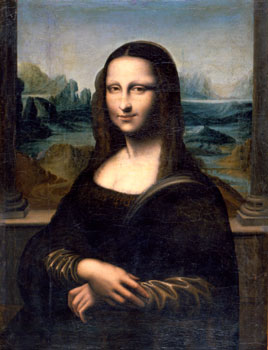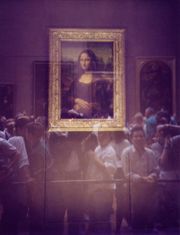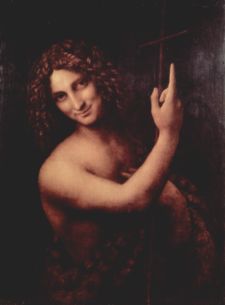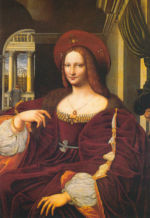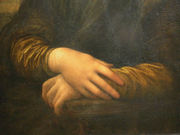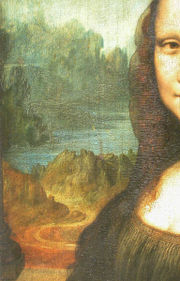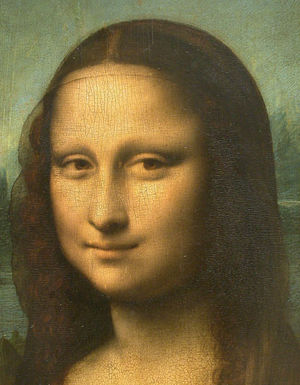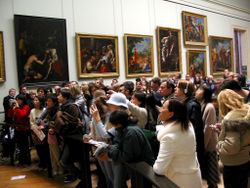Mona Lisa
2007 Schools Wikipedia Selection. Related subjects: Art
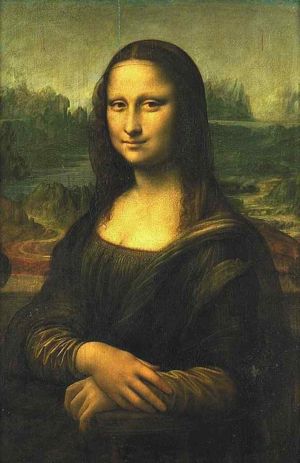 |
| Mona Lisa |
| Leonardo da Vinci, circa 1503– 1507 |
| oil on poplar |
| 77 × 53 cm, 30 × 21 inches |
| Musée du Louvre, Paris |
Mona Lisa, or La Gioconda (La Joconde), is a 16th-century oil painting on poplar wood by Leonardo da Vinci, and is arguably the most famous painting in the world. Few works of art have been subject to as much scrutiny, study, mythologizing and parody. It is owned by the French government and hangs in the Musée du Louvre in Paris.
The painting, a half-length portrait, depicts a woman whose gaze meets the viewer's with an expression often described as enigmatic.
Title of the painting
The title Mona Lisa stems from the Giorgio Vasari biography of Leonardo da Vinci, published 31 years after Leonardo's death. In it, he identified the sitter as Lisa Gherardini, the wife of wealthy Florentine businessman Francesco del Giocondo. "Mona" was a common Italian contraction of " madonna," meaning "my lady," the equivalent of the English "Madam," so the title means "Madam Lisa". In modern Italian the short form of "madonna" is usually spelled "Monna," so the title is sometimes given as Monna Lisa. This is rare in English, but more common in Romance languages. The alternative title La Gioconda is the feminine form of Giocondo. In Italian, giocondo also means 'light-hearted' ('jocund' in English), so "gioconda" means "light-hearted woman". Because of her smile, this version of the title plays on this double-meaning, as does the French "La Joconde".
Both Mona Lisa and La Gioconda became established as titles for the painting in the 19th century. Before these names became established, the painting had been referred to by various descriptive phrases, such as "a certain Florentine lady" and "a courtesan in a gauze veil."
History
16th century
Leonardo began painting the Mona Lisa in 2007 and, according to Vasari, completed it in four years.
Leonardo took the painting from Italy to France in 1516 when King François I invited the painter to work at the Clos Lucé near the king's castle in Amboise. The King bought the painting for 4,000 écus and kept it at Fontainebleau, where it remained until moved by Louis XIV.
Many art historians believe that after Leonardo's death the painting was cut down by having part of the panel at both sides removed. Originally there appear to have been columns on both sides of the figure, as can be seen in early copies. The edges of the bases can still be seen in the original. However, some art historians, such as Martin Kemp, argue that the painting has not been altered, and that the columns depicted in the copies were added by the copyists. There are also copies in which the figure appears nude.
Other versions
It has been suggested that Leonardo created more than one version of the painting. The owners of the version known as the Isleworth Mona Lisa claim that it is an original, though the great majority of art historians reject its authenticity. The same claim has been made for a version in the Vernon collection. Another version, dating from c.1616 was given in c. 1790 to Joshua Reynolds by the Duke of Leeds in exchange for a Reynolds self-portrait. Reynolds thought it to be the real painting and the French one a copy, which has now been disproved. It is, however, useful in that it was copied when the original's colours were far brighter than they are now, and so it gives some sense of the original's appearance 'as new'. It is held in the stores of the Dulwich Picture Gallery. The nude versions have also led to speculation that they were copied from a lost Leonardo original depicting Lisa naked.
17th to 19th century
Louis XIV moved the painting to the Palace of Versailles. After the French Revolution, it was moved to the Louvre. Napoleon I had it moved to his bedroom in the Tuileries Palace; later it was returned to the Louvre. During the Franco-Prussian War of 1870– 1871, it was moved from the Louvre to a hiding place elsewhere in France.
The painting was not well-known until the mid-19th century, when artists of the emerging Symbolist movement began to appreciate it, and associated it with their ideas about feminine mystique. Critic Walter Pater, in his 1867 essay on Leonardo, expressed this view by describing the figure in the painting as a kind of mythic embodiment of eternal femininity, who is "older than the rocks among which she sits" and who "has been dead many times and learned the secrets of the grave".
20th century to present
Theft
The painting's increasing fame was further emphasised when it was stolen on August 21, 1911. The next day, Louis Béroud, a painter, walked into the Louvre and went to the Salon Carré where the Mona Lisa had been on display for five years. However, where the Mona Lisa should have stood, in between Correggio's Mystical Marriage and Titian's Allegory of Alfonso d'Avalos, he found four iron pegs.
Béroud contacted the section head of the guards, who thought the painting was being photographed. A few hours later, Béroud checked back with the section head of the museum, and it was confirmed that the Mona Lisa was not with the photographers. The Louvre was closed for an entire week to aid in the investigation of the theft.
On September 6, avant-garde French poet Guillaume Apollinaire, who had once called for the Louvre to be "burnt down", was arrested and put in jail on suspicion of the theft. His friend Pablo Picasso was brought in for questioning, but both were later released. At the time, the painting was believed to be lost forever. It turned out that Louvre employee Vincenzo Peruggia stole it by entering the building during regular hours, hiding in a broom closet and walking out with it hidden under his coat after the museum had closed. Con-man Eduardo de Valfierno master-minded the theft, and had commissioned the French art forger Yves Chaudron to make copies of the painting so he could sell them as the missing original. Because he did not need the original for his con, he never contacted Peruggia again after the crime. After keeping the painting in his apartment for two years, Peruggia grew impatient and was caught when he attempted to sell it to a Florence art dealer; it was exhibited all over Italy and returned to the Louvre in 1913.
Second World War
During World War II the painting was again removed from the Louvre and taken to safety, first in Chateau Amboise, then in the Loc-Dieu Abbey and finally in the Ingres Museum in Montauban.
Post-war
In 1956, the lower part of the painting was severely damaged when someone doused it with acid. On December 30 of that same year, Ugo Ungaza Villegas, a young Bolivian, damaged the painting by throwing a rock at it. The result was a speck of pigment near Mona Lisa's left elbow. The painting is now covered with bulletproof security glass.
From December 14, 1962 to March of 1963, the French government lent it to the United States to be displayed in New York City and Washington D.C. In 1974, the painting exhibited in Tokyo and Moscow before being returned to the Louvre.
Prior to the 1962-63 tour, the painting was assessed for insurance purposes at $100 million. According to the Guinness Book of Records, this makes the Mona Lisa the most valuable painting ever insured. As an expensive painting, it has only recently been surpassed (in terms of actual dollar price) by Gustav Klimt 's Adele Bloch-Bauer I, which was sold for $135 Million (£73 million) on 19 June 2006. Although this figure is greater than that which the Mona Lisa was insured for, the comparison does not account for the change in prices due to inflation -- $100 million in 1962 is approximately $645 million in 2005 when adjusted for inflation using the US Consumer Price Index.
In 2004 experts from the National Research Council of Canada conducted a three-dimensional infrared scan. Because of the aging of the varnish on the painting it has been difficult to discern details. Data from the scan and infrared reflectography were later used by Bruno Mottin of the French Museums' "Centre for Research and Restoration" to argue that the transparent gauze veil worn by the sitter is a guarnello, typically used by women while pregnant or just after giving birth. A similar guarnello was painted by Sandro Botticelli in his Portrait of Smeralda Brandini (1470), depicting a pregnant woman ( on display in the Victoria and Albert Museum in London). Furthermore, this reflectography revealed that Mona Lisa's hair is not loosely hanging down, but seems attached at the back of the head to a bonnet or pinned back into a chignon and covered with a veil, bordered with a sombre rolled hem. In the 16th century, hair hanging loosely down on the shoulders, was the customary apanage of unmarried young women or prostitutes. This apparent contradiction with her status as a married woman has now been resolved.
Researchers also used the data to reveal details about the technique used and to predict that the painting will degrade very little if current conservation techniques are continued.
On April 6, 2005 — following a period of curatorial maintenance, recording, and analysis — the painting was moved, within the Louvre, to a new home in the museum's Salle des États. It is displayed in a purpose-built, climate-controlled enclosure behind bullet proof glass. The Mona Lisa has since undergone a major scientific observation, and it has been proved through infrared cameras she is wearing a bonnet and clenching her chair (something that da Vinci decided to change as an afterthought).
Identity of the model
Lisa Gherardini
Vasari identified the subject to be the wife of socially prominent Francesco del Giocondo, who was a silk merchant of Florence. Until recently, little was known about his third wife, Lisa Gherardini, except that she was born in 1479, raised at her family's Villa Vignamaggio in Tuscany and that she married del Giocondo in 1495.
In 2004 the Italian scholar Giuseppe Pallanti published Monna Lisa, Mulier Ingenua (literally '"Mona Lisa: Real Woman", published in English under the title Mona Lisa Revealed: The True Identity of Leonardo's Model). The book gathered archival evidence in support of the traditional identification of the model as Lisa Gherardini. According to Pallanti, the evidence suggests that Leonardo's father was a friend of del Giocondo. "The portrait of Mona Lisa, done when Lisa Gherardini was aged about 24, was probably commissioned by Leonardo's father himself for his friends as he is known to have done on at least one other occasion." Pallanti discovered that Lisa and Francesco had five children and that she outlived her husband. She lived at least into her 60s, though no record of her death was located.
In September 2006 Bruno Mottin argued that the guarnelo he studied using the 2004 scan data suggested that the painting dated from around 1503 and commemorated the birth of Lisa Gherardini's second son.
Other suggestions
Vasari, however, wrote about the portrait, and described it, without ever having seen it; the painting was already in France in Vasari's era. So various alternatives to the traditional sitter have been proposed. During the last years of his life, Leonardo spoke of a portrait "of a certain Florentine lady done from life at the request of the magnificent Giuliano de' Medici." No evidence has been found that indicates a link between Lisa Gherardini and Giuliano de' Medici, but then the comment could instead refer to one of the two other portraits of women executed by da Vinci. A later anonymous statement created confusion when it linked the Mona Lisa to a portrait of Francesco del Giocondo himself – perhaps the origin of the controversial idea that it is the portrait of a man.
Dr. Lillian Schwartz of Bell Labs suggests that the Mona Lisa is actually a self-portrait. She supports this theory with the results of a digital analysis of the facial features of Leonardo's face and that of the famous painting. When flipping a self-portrait drawing by Leonardo and then merging that with an image of the Mona Lisa using a computer, the features of the faces align perfectly. Critics of this theory suggest that the similarities are due to both portraits being painted by the same person using the same style. Additionally, the drawing on which she based the comparison may not be a self-portrait.
Serge Bramly, in his biography of Leonardo, discusses the possibility that the portrait depicts the artist's mother Caterina. This would account for the resemblance between artist and subject observed by Dr. Schwartz, and would explain why Leonardo kept the portrait with him wherever he travelled, until his death.
Art historians have also suggested the possibility that the Mona Lisa may only resemble Leonardo by accident: as an artist with a great interest in the human form, Leonardo would have spent a great deal of time studying and drawing the human face, and the face most often accessible to him was his own, making it likely that he would have the most experience with drawing his own features. The similarity in the features of the people depicted in paintings such as the Mona Lisa and St. John the Baptist may thus result from Leonardo's familiarity with his own facial features, causing him to draw other, less familiar faces in a similar light.
Maike Vogt-Lüerssen argues that the woman behind the famous smile is Isabella of Aragon, the Duchess of Milan. Leonardo was the court painter for the Duke Of Milan for 11 years. The pattern on Mona Lisa's dark green dress, Vogt-Lüerssen believes, indicates that she was a member of the house of Sforza. Her theory is that the Mona Lisa was the first official portrait of the new Duchess of Milan, which requires that it was painted in spring or summer 1489 (and not 1503). This theory is allegedly supported by another portrait of Isabella of Aragon, painted by Raphael, ( Doria Pamphilj Gallery, Rome).
Aesthetics
Leonardo used a pyramid design to place the woman simply and calmly in the space of the painting. Her folded hands form the front corner of the pyramid. Her breast, neck, and face glow in the same light that softly models her hands. The light gives the variety of living surfaces an underlying geometry of spheres and circles.Leonardo refered to a seemingly simple formula for sitted female figure: the images of sitted Madonna, which were widely spread at the time. He effectively modificated this fomular in order to create the visual impression of distance between the sitter and the observer. The armrest of the chair functions as a dividing element between Mona Liza and us. The woman sits markedly upright with her arms folded, which is also a sign of her reserved posture. Only her gaze is fixed on the observer and seems to welcome him to this silent communication. Since the brightly lit face is practically framed with various much darker elements (hair, veil, shadows), the observer's attraction to Mona Lisa's face is brought to even greater extent. Thus, the composition of the figure evocates an ambiguos effect: we are attracted to this mystirious woman but have to stay at a distance as if she was a divine creature. There is no indication of an intimate dialogue between the woman and the observer like it is the case in the Portrait of Baltasare Castiglione (Louvre) pained by Raphael about ten years after Mona Lisa and undoubtedly influenced by Leonardo's portrait.
The painting was one of the first portraits to depict the sitter before an imaginary landscape. The enigmatic woman is portrayed seated in what appears to be an open loggia with dark pillar bases on either side. Behind her a vast landscape recedes to icy mountains. Winding paths and a distant bridge give only the slightest indications of human presence. The sensuous curves of the woman's hair and clothing, created through sfumato, are echoed in the undulating imaginary valleys and rivers behind her. The blurred outlines, graceful figure, dramatic contrasts of light and dark, and overall feeling of calm are characteristic of Leonardo's style. Due to the expressive synthesis that Leonardo achieved between sitter and the landscape it is arguable whether Mona Lisa should be considered as a portrait, for it represents rather an ideal than a real woman. The sense of overall harmony achieved in the painting—especially apparent in the sitter's faint smile— reflects Leonardo's idea of the cosmic link connecting humanity and nature, making this painting an enduring record of Leonardo's vision and genius.
Mona Lisa's smile has repeatedly been a subject of many - frequently rediculous - interpretations.Sigmund Freud interpreted the 'smile' as signifying Leonardo's erotic attraction to his dear mother; others have described it as both innocent and inviting. Many researchers have tried to explain why the smile is seen so differently by people. The explanations range from scientific theories about human vision to curious supposition about Mona Lisa's identity and feelings. Professor Margaret Livingstone of Harvard University has argued that the smile is mostly drawn in low spatial frequencies, and so can best be seen from a distance or with one's peripheral vision. Thus, for example, the smile appears more striking when looking at the portrait's eyes than when looking at the mouth itself. Christopher Tyler and Leonid Kontsevich of the Smith-Kettlewell Institute in San Francisco believe that the changing nature of the smile is caused by variable levels of random noise in human visual system. Dina Goldin, Adjunct Professor at Brown University, has argued that the secret is in the dynamic position of Mona Lisa's facial muscles, where our mind's eye unconsciously extends her smile; the result is an unusual dynamicity to the face that invokes subtle yet strong emotions in the viewer of the painting.
In late 2005, Dutch researchers from the University of Amsterdam ran the painting's image through an "emotion recognition" computer software developed in collaboration with the University of Illinois at Urbana-Champaign. The software found the smile to be 83% happy, 9% disgusted, 6% fearful, 2% angry, less than 1% neutral, and not surprised at all. Rather than being a thorough analysis, the experiment was more of a demonstration of the new technology. The faces of ten women of Mediterranean ancestry were used to create a composite image of a neutral expression. Researchers then compared the composite image to the face in the painting. They used a grid to break the smile into small divisions, then checked it for each of six emotions: happiness, surprise, anger, disgust, fear, and sadness.
It is also notable that Mona Lisa has no visible facial hair at all - including eyebrows and eyelashes. Some researchers claim that it was common at this time for genteel women to pluck them off, since they were considered to be unsightly. Yet it is more reasonable to assume that Leonardo did not finished the painting, for almost all of his paintings are unfinished. Being a perfectionist he always tried to go one step further in improving his technique. Furthermore, other women of the time were predominantly portraited with eybrows. For modern viewers the missing eywbrows add to the slightly semi-abstract quality of the face though it was not Leonardo's aim.
The painting has been restored numerous times; X-ray examinations have shown that there are three versions of the Mona Lisa hidden under the present one. The thin poplar backing is beginning to show signs of deterioration at a higher rate than previously thought, causing concern from museum curators about the future of the painting.
Role in popular culture and avant-garde art
The Mona Lisa has acquired an iconic status in popular culture. In 1963, pop artist Andy Warhol started making colorful serigraph prints of the Mona Lisa. Warhol thus consecrated her as a modern icon, similar to Marilyn Monroe or Elvis Presley. At the same time, his use of a stencil process and crude colors implies a criticism of the debasement of aesthetic values in a society of mass production and mass consumption. Today the Mona Lisa is frequently reproduced, finding its way on to everything from carpets to mouse pads.
As a cult painting, the Mona Lisa has enjoyed countless references in both popular culture and avant-garde art. It has been a subject of many songs, including:
- "Mona Lisa" ( 1950), a ballad sung by Nat King Cole comparing his love to the painting, was the #1 Billboard Pop single for 8 weeks and went on to sell 3 million copies. The song was written by Jay Livingston and Ray Evans for the film Captain Carey, USA and was awarded an Oscar. It was later used in the 1986 film Mona Lisa. A cover of the song appears on the Me First and the Gimme Gimmes album Take a Break. Conway Twitty released a rewritten rock and roll version in 1959.
- Bob Dylan's song " Visions of Johanna" ( 1966), which includes the lines "But Mona Lisa must have had the highway blues./You can tell by the way she smiles."
- "Mona Lisas and Mad Hatters", a song on Elton John's 1972 album, Honky Chateau. It rose to #1 in the Billboard Music Charts
- "Mona Lisa", the first track on country singer Willie Nelson's 1981 album, Somewhere over the Rainbow. The album rose to#1 on the Billboard Top Country Albums chart.
- "Mona Lisa", a song on hip hop performer Slick Rick's 1988 album, The Great Adventures of Slick Rick. The album rose to#1 on the Billboard Top R&B/Hip Hop Albums chart.
- "Mona Lisa", is the first track on rock singer Jesse Malin's 2004 album, The Heat.
- "A Mona Lisa", an unreleased song by the rock band Counting Crows. It was written by lead singer Adam Duritz and recorded in 1992.
- "Mona Lisa", a song by the German Electrogoth band Unheilig suggests her smile is the result of the singer's hand underneath her skirt.
- "Mona Lisa", a rare song by Britney Spears. The song tells of a legendary female icon named "Mona Lisa" who has fallen from grace and is simply remembered for being mysterious and enigmatic, much like the painting. Interpretations of the lyrics have led to the comparisons between the Mona Lisa and Spears' career.
- "You're the Top" by Cole Porter, includes the line 'you're the smile on the Mona Lisa'.
- "Grown and Sexy" by Chamillionaire, includes the line 'her face was the Mona Lisa, her ass was a masterpiece.'
- Santana's 1999 hit song " Smooth" featuring Rob Thomas featured the line "My muñequita, my Spanish Harlem Mona Lisa". Smooth was a song written by Thomas about his wife of Spanish background, Marisol Maldonado.
- "Black Mona Lisa" was one of the singles from Lamya's album "Learning from falling". It is a homage to her mother and the strength and self-worth that she gave her.
- "Mona Lisa" is a track off of the Japanese band nil's minialbum "Sayonara da Vinci."
There have been many films, inspired by the painting that used variations of La Gioconda and Mona Lisa as titles. Some of these are about the painting itself, while others, such as the 1986 comedy drama Mona Lisa or the 2003 feminist drama Mona Lisa Smile with Julia Roberts are about women whose characters were inspired by the painting.
The avant-garde art world has also taken note of the undeniable fact of the Mona Lisa's popularity. Because of the painting's overwhelming stature, Dadaists and Surrealists often produce modifications and caricatures. In 1919, Marcel Duchamp, one of the most influential Dadaists, made a Mona Lisa parody by adorning a cheap reproduction with a moustache and a goatee, as well as adding the rude inscription L.H.O.O.Q., when read out loud in French sounds like "Elle a chaud au cul" (translating to "she has a hot arse" as a manner of implying the woman in the painting is in a state of sexual excitement and availability). This was intended as a Freudian joke, referring to Leonardo's alleged homosexuality. According to Rhonda R. Shearer, the apparent reproduction is in fact a copy partly modelled on Duchamp's own face. Salvador Dalí, famous for his pioneering surrealist work, painted Self portrait as Mona Lisa in 1954.
Many works played, often in a humorous way, on the mysteries and controversies of Mona Lisa's history. Fantastic theories and conspiracies are often entertained by authors of fiction.
In 1952, science fiction/fantasy author Ray Bradbury published a short story titled "The Smile", which dealt with the reaction of people in a dystopic future to the Mona Lisa. The story places the painting on canvas, while the real painting is on poplar wood.
In a 1965 episode of Voyage to the Bottom of the Sea entitled "The Buccaneer", an art thief named Logan plans to steal La Gioconda from the French warship transporting it on a world tour.
In a 1965 episode of The Wild Wild West entitled "The Night of the Torture Chamber" a mad art collector plans to replace a United States Governor with a double, then ransack the state's treasury in order to buy La Gioconda from the French Government.
Bob Shaw's 1976 humorous short story "The Giaconda Caper", published in his collection " Cosmic Kaleidoscope", suggests that the painting is part of a sequence which together forms a brief animation, and that da Vinci even created a machine to view them.
The 1979 serial City of Death in the science fiction television series Doctor Who revolves around da Vinci making copies of the Mona Lisa. The story suggests that the painting now in the Louvre is painted on top of the message "This is a fake" written in modern felt tip pen.
A 1979 episode of the classic anime Lupin III entitled "Mona Lisa Smiles Twice" finds Lupin and his gang attempting to steal the Mona Lisa. After many attempts gone wrong, he finally succeeds at the end of the episode, only to discover a curator at the Louvre, to protect the original, began painting perfect replicas for tours and display. However, the curator has painted so many that even he does not know which is the original Mona Lisa from all of the duplicates

A 1984 episode of "The Adventures of Sherlock Holmes", The Adventure of the Final Problem, features Holmes' nemesis, Professor Moriarty, stealing the Mona Lisa and making copies of it to sell as originals. In the show, the thief rolls the Mona Lisa up into a tube, which should not be possible if the painting is on poplar.
The 1991 Bruce Willis film Hudson Hawk opens with a scene set in the past, featuring Leonardo da Vinci. In this scene, he mulls over finishing the Mona Lisa, which is complete except for the mouth. The model he is using smiles, revealing extremely bad teeth, which likely prompted him to finish the painting with her smiling as she does.
Good Omens, a 1990 novel by Terry Pratchett and Neil Gaiman, features a character called Anthony Crowley who owns the original cartoon of the Mona Lisa and displays it as the only piece of art in his London flat. Crowley is a demon who has been on Earth since the Fall of Man. He met da Vinci in 16th Century Italy and obtained the cartoon whilst drinking with the polymath. Leonardo and Crowley agree that the cartoon is superior to the finished version ("I got the bloody smile all right in the roughs").
In the 1990 Star Trek: The Next Generation episode " The Most Toys", an alien who is an obsessive collector owns the Mona Lisa. He also acquires the android Data, who tries to imitate the painting's smile.
Eduard Gufeld, the late Ukrainian- American chess grandmaster, published a book in 1994 entitled My Life in Chess: The Search for La Gioconda. In 2001, a revised edition entitled Chess: The Search for the Mona Lisa was released. In the book, Gufeld discussed his quest to play the perfect chess masterpiece. He felt that he had realized this dream in his famous 1973 game against Bagirov.
An episode of the Disney cartoon Doug revolves around the making of a musical play about the painting coming to life and Leonardo having to find her.
The 1962 Looney Tunes cartoon "Louvre Come Back To Me!", starring Pepé Le Pew, features the Mona Lisa in the finale; as Le Pew's visible odour reaches the painting, it comes to life and says, "I can tell you chaps one thing: it's not always easy to hold this smile." This cartoon was also edited into the compilation feature Daffy Duck's Fantastic Island.
The February 8, 1999 edition of The New Yorker ran for its cover Dean Rohrer's Mona Monica, an amalgamation of the Mona Lisa and Monica Lewinsky.
In a sketch on The Ronnie Johns Half Hour, Chopper Read was auctioning some artworks of which the Mona Lisa was one of. He "enhanced the value" by drawing a mastache on the painting, and entitling it, "Chopper Lisa".
In Kurt Wimmer’s 2002 cult film Equilibrium, the Mona Lisa is found by the Tetragrammaton, a group who seek out people who have "feelings". Since emotion is outlawed in the future in this film, those who refuse to take drugs that inhibit the ability to feel are hunted down. Most who refuse to take the drugs are holed up in the outer rim of the city and collect and protect art (and other emotion-generating media such as recordings of music) with their lives seeing it as something precious. The Mona Lisa is found and burned by flamethrowers as cleric John Preston finds the painting along with other artifacts securely hidden in a hidden compartment.
The painting features significantly in The Da Vinci Code, a popular novel written by Dan Brown in 2003 and, much more briefly, a film released on May 19, 2006 (directed by Ron Howard, starring Tom Hanks, Ian McKellen and Alfred Molina). In the novel, Brown's protagonist, Harvard professor Robert Langdon, claims that the painting expresses Leonardo's belief in the " sacred feminine" and that the title is a coded reference to the Egyptian gods Amon and Isis, "Mona" being an anagram of the former and "Lisa" being a contraction of l'Isa, meaning Isis. This hidden reference is supposed to signify Leonardo's secret opposition to orthodox Christianity and belief in the ideal union of masculine and feminine principles, as does the sitter's androgynous features. In this context he also refers to the self-portrait theory. In the film these ideas are not expressed.
In the 2003 comedy Looney Tunes: Back in Action, stuntman DJ Drake ( Brendan Fraser) looks through an embedded "X-ray" lens in a playing card — a queen of diamonds with Mona Lisa as Queen — to examine the original Mona Lisa at the Louvre, discovering a hidden map under the painting.
The titles of two episodes of The Simpsons were homophones of the painting's title ( Moaning Lisa and Moe'N'a Lisa, respectively).
One of the things that the dwarves in Time Bandits steal is the Mona Lisa.
In the video games Animal Crossing and Animal Crossing: Wild World, the Famous Painting depicts the Mona Lisa.
In the video game Max Payne there are twin characters named 'Mona' and 'Lisa'. 'Lisa' dies in the first game and 'Mona' is a main character in the sequel Max Payne 2: The Fall of Max Payne.
The Case of The Missing Masterpiece from the 1988-1989 animated series C.O.P.S. shows Big Boss sending his crooks out to steal the Mona Lisa so he can start his own stolen art collection with it. The C.O.P.S. team must put a stop to this caper and return the stolen painting back to where it belongs.
In "Looney Tunes: Back in Action" the video game, there exists a level called "The Louvre" and close inspection of the surroundings can reveal the Mona Lisa painting.
The time-travel card game Chrononauts features cards representing three versions of the Mona Lisa: The Real Thing, an Excellent Forgery, and an Obvious Forgery (which, in later versions of the game, sports a handlebar mustache).
You can find the Mona Lisa within the Disneyland attraction Pinocchio's Daring Journey.
A reproduction of the Mona Lisa was discovered painted onto a hillside near Newport, Oregon on August 15th, 2006. It was created by artist Samuel Clemens using a tarp stencil and water-based paint. Seattle Post-Intelligencer News Article
In the first episode of "Where on Earth is Carmen Sandiego?": "The Stolen Smile." Carmen Sandiego steals the smile right off the painting.. Also in the second episode of the first season of the game show, "Where in the World is Carmen Sandiego?", Vic the Slick steals the Mona Lisa. He saws it off, but Vic does the impossible roll-up as usual. In a mission in the "Where in Time is Carmen Sandiego/Carmen's Great Time Case" computer game, you help Leonardo Di Vinci to make the "Mona Lisa" model laugh.
Parody and imitative versions of the Mona Lisa include a cow, gorilla, mouse, rabbit, and Miss Piggy as Mona Lisa .
In the 1985 the Garbage Pail Kids trading cards, created by Topps, had two parodies of the Mona Lisa. They were released in the 2nd Series - Card Number 67a was Phony Lisa, Card 67b was Mona Loser.
The 1998 movie Ever After starring Drew Barrymore included Leonardo da Vinci as the character of the "fairy godmother" to Barrymore's "Cinderella". The movie includes a scene where da Vinci has been robbed on his way to the castle and asks the Prince to save a painting taken by a gypsy. When the prince returns the painting to da Vinci, Leonardo shows the prince the painting, which is the Mona Lisa (on canvas).
